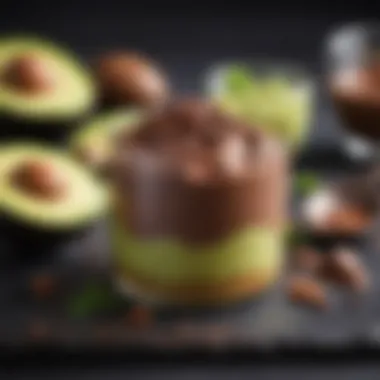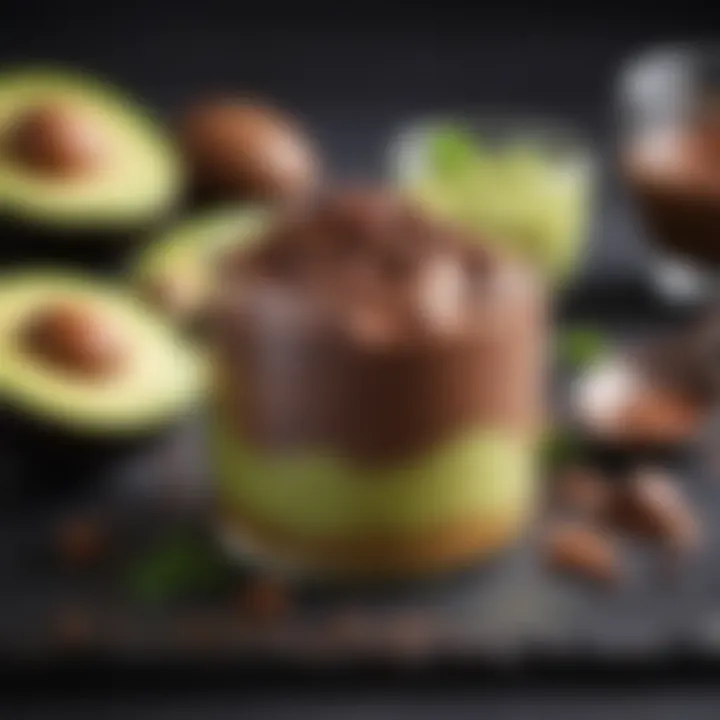Exploring Good Keto Desserts: A Comprehensive Guide


Intro
As more individuals embrace the ketogenic lifestyle, the quest for enjoyable desserts becomes paramount. This guide aims to illuminate the world of keto desserts, offering insights into their preparation, nutritional value, and diversity. It is essential to recognize that desserts need not be sacrificed on this diet. Instead, they can be crafted in a manner that aligns perfectly with low-carb parameters while still delivering on flavor and satisfaction. From innovative recipes to practical tips, this guide serves as a resource for anyone wishing to explore the realm of keto-friendly sweet treats.
Understanding Keto Desserts
The emerging popularity of keto diets has sparked significant interest in finding suitable dessert options. Understanding keto desserts is essential for those who wish to enjoy sweet treats while adhering to a low-carbohydrate regimen. This section will provide insight into what defines keto desserts and their nutritional aspects, which make them appealing for those prioritizing health and lifestyle.
Defining Keto Desserts
Keto desserts are defined primarily by their low carbohydrate content. These desserts aim to provide sweetness and satisfaction without disrupting the state of ketosis, which is the metabolic condition the body enters when it burns fat instead of carbohydrates for fuel. The key to defining a keto dessert lies in the choice of ingredients—alternatives must be used in place of traditional flours and sugars.
More specifically, any dessert that contains less than 5 grams of net carbs per serving is typically considered a keto dessert. Popular examples include almond flour cakes, sugar-free brownies, and coconut flour cookies. These choices are made not just for their nutritional profile, but for their ability to closely mimic the texture and taste of conventional desserts.
Nutritional Profile of Keto Desserts
Keto desserts offer a distinct nutritional profile compared to standard desserts. They prioritize low-carbohydrate ingredients, healthy fats, and suitable sugar alternatives. This profile contributes to several potential benefits, including sustained energy levels and reduced sugar cravings.
Low-Carbohydrate Ingredients
Low-carbohydrate ingredients are the backbone of any keto dessert. Instead of using traditional flour, which is high in carbs, recipes might employ almond flour or coconut flour. These alternatives are not only lower in carbohydrates but also high in fiber and protein. The key characteristic of low-carbohydrate ingredients is their ability to maintain flavor and texture without the abundance of carbs that would otherwise spike blood sugar levels. The distinct advantage here is their role in helping individuals stay within their daily carb limits while still enjoying desserts.
Healthy Fats in Desserts
Healthy fats play a crucial role in keto desserts. Fats such as coconut oil and grass-fed butter are common in recipes. These fats contribute to the creamy texture while providing nutritional benefits, such as improved satiety. A main aspect of healthy fats is their energy-dense nature, which can support the body in maintaining energy levels throughout the day. However, balance is important; excess fat intake may lead to unwanted weight gain if not monitored.
Sugar Alternatives
Sugar alternatives, such as erythritol and stevia, have gained popularity because they provide sweetness without the carbohydrates associated with regular sugar. These substitutes can help satisfy sweet cravings while preventing blood sugar spikes. One major characteristic of these alternatives is their ability to mimic the taste of sugar, making keto desserts enjoyable without sacrificing flavor. The potential disadvantages include digestive discomfort for some individuals when consumed in large quantities, so moderation is essential.
Keto desserts can fit seamlessly into a ketogenic diet, allowing individuals to indulge their sweet tooth guilt-free.
By exploring these elements, we establish a foundation for understanding why keto desserts do not only exist but also thrive in the current dietary landscape. Nutritional insights contribute greatly to their attractiveness, offering a blend of indulgence and adherence to dietary goals.
Key Ingredients in Keto Desserts
Understanding the key ingredients that make up keto desserts is essential. These ingredients not only determine the flavor and texture but also the nutritional value that aligns with a ketogenic diet. Each component plays a unique role in crafting desserts that satisfy cravings while adhering to dietary restrictions. Therefore, it is important to choose these elements wisely, as they can significantly impact the overall success of these recipes.
Common Keto-Friendly Flours
When creating keto desserts, traditional flours are often replaced with keto-friendly alternatives. Options such as almond flour, coconut flour, and flaxseed meal are popular choices.
- Almond Flour: This flour is rich in healthy fats and fiber while being low in carbohydrates. It adds a moist texture to baked goods and can be used in various dessert recipes.
- Coconut Flour: This option is highly absorbent and requires less quantity in recipes. It provides a subtle coconut flavor and is lower in calories.
- Flaxseed Meal: This flour is good for adding fiber and omega-3 fatty acids. It can also act as an egg substitute when mixed with water, offering a binding property in baking.
Using these flours properly can enhance the taste and nutritional profile of the dessert without sacrificing the desired low-carb content.


Natural Sweeteners for Keto
Sweetness is often a key factor in desserts. However, regular sugars are not compatible with a keto diet. Instead, natural sweeteners provide a viable alternative. Some common options include:
- Stevia: A plant-derived sweetener that is zero-calorie and does not impact blood sugar levels.
- Erythritol: A sugar alcohol that offers a sweet taste without the calories. It has minimal effect on glucose and insulin levels.
- Monk Fruit: Another natural sweetener that contains no calories and is many times sweeter than sugar.
These sweeteners can give the desserts the desired taste while keeping them keto-friendly.
Fats and Solidifiers
Fats play a crucial role in keto desserts, balancing taste and texture while supporting the ketogenic principles.
Butter vs. Coconut Oil
Both butter and coconut oil are favored in keto baking, but they contribute different qualities. Butter provides a rich flavor and creamy texture, lending itself well to baking. Coconut oil offers a subtle sweetness and is plant-based, making it a popular choice among vegans. It's important to understand the melting point of these fats as it can affect the final texture of the dessert. In terms of health, both options offer good fats, but coconut oil is higher in medium-chain triglycerides, which are beneficial for energy levels.
Eggs as Binding Agents
Eggs are vital in keto dessert recipes. They function as binding agents, helping to hold together the mixture, which can be particularly useful in gluten-free baking. Their ability to enhance moisture and richness is unmatched. Eggs are a source of protein, thus adding nutritional value. While most recipes call for large eggs, it is important to adjust quantities based on the specific needs of each dessert.
Popular Types of Keto Desserts
Keto desserts offer a wide variety of flavors and textures that appeal to different taste preferences. In the realm of a ketogenic diet, which fundamentally reduces carbohydrate intake to promote fat-burning, these desserts can provide a sweet balance to meals. It is important for individuals following such a diet to know there are options that satisfy cravings without significantly impacting their nutritional goals. The diverse types of keto desserts include cakes, mousses, frozen treats, and cookies. Each of these brings unique characteristics that deserve exploration.
Keto Cakes and Cupcakes
Keto cakes and cupcakes are popular for several reasons. First, they present an opportunity to celebrate special occasions without straying from dietary preferences. Many recipes utilize almond flour or coconut flour, which are lower in carbohydrates than traditional wheat flour. These flours contribute to a moist texture while keeping the carb count down. Often, keto cakes feature sugar substitutes like erythritol or stevia, allowing for sweetness without the insulin spike associated with sugar. However, achieving the right balance in flavor and texture can take practice.
Mousse and Puddings
Mousse and puddings offer a creamy, indulgent dessert option for those on a keto diet. Typically made with heavy cream, cocoa powder, and a keto-friendly sweetener, they are not only high in fat but also provide satisfaction to those needing a quick dessert. These desserts are versatile, allowing for various flavorings, such as vanilla or coffee, to enhance the experience. The light texture of mousses often elevates them above heavier desserts, making them appealing after a meal.
Frozen Delights
Frozen delights are especially popular during warmer months or after meals as a refreshing option. Within this category, two notable subtypes are Ice Cream Alternatives and Sorbet Variations.
Ice Cream Alternatives
Ice cream alternatives are significant within keto desserts due to their capability to mimic traditional ice cream while staying compliant with dietary guidelines. Products often use full-fat dairy or coconut cream as bases, paired with low-carb sweeteners. This makes them a favorite for those craving something cold and sweet. The rich texture is one of the key characteristics that makes these alternatives appealing. However, it is essential to be mindful of portion sizes, as some brands may contain hidden sugars or carbs depending on the ingredients used.
Sorbet Variations
Sorbet variations represent another refreshing avenue for keto desserts. Typically fruit-based, these can be made with low-carb fruits like berries or avocados. Depending on the preparation, sorbets can remain low in calories while still offering a burst of flavor ideal for warm days. The main advantage of sorbet variations is their lightness and the ability to create a variety of flavors using simple ingredients. However, careful consideration is necessary to avoid high-sugar fruits, which can lead to a higher carbohydrate count than desired in a keto diet.
Cookies and Brownies
Cookies and brownies provide a classic, beloved dessert experience for many. Keto versions often utilize nut flours and alternative sweeteners, achieving a satisfying treat without excessive carbs. They can be made in batches and individually portioned, making them convenient for snacking or as an after-meal treat.


Overall, the variety of keto dessert types serves to cater to diverse preferences while supporting a low-carbohydrate lifestyle. Understanding these options allows individuals to navigate sweet cravings effectively while adhering to their dietary goals.
Health Benefits of Keto Desserts
Understanding the health benefits of keto desserts is vital when following a ketogenic lifestyle. Keto desserts can play a significant role in maintaining a low-carbohydrate diet while satisfying the desire for sweet treats. This balance is critical for individuals aiming for weight loss, glucose control, or improved overall health. The following sections will delve into specific benefits that keto desserts provide, touching on how they can help maintain ketosis, control sugar cravings, and contribute to nutrient density and satisfaction.
Maintaining Ketosis
Ketosis is a metabolic state where the body uses fat as its primary energy source instead of carbohydrates. Consuming keto desserts that are low in carbohydrates can help in maintaining this state. The right combination of ingredients, such as almond flour and erythritol, can keep blood sugar levels stable.
When baking, it is important to select recipes that adhere to low-carb guidelines. Many traditional desserts are rich in sugars and simple carbs, which can disrupt ketosis. By substituting these ingredients, keto desserts help keep the body in fat-burning mode.
Maintaining ketosis not only aids in weight loss but also can enhance energy levels and mental clarity. Some people report improved concentration and reduced fatigue when they stick to a ketogenic diet.
Controlling Sugar Cravings
One of the most challenging aspects of reducing sugar intake is managing cravings. Keto desserts can be a useful tool here, as they provide sweet flavors without the associated sugar rush or crash. The use of natural sweeteners, such as monk fruit or stevia, offers a satisfying alternative that doesn't spike insulin levels.
By indulging in these desserts, individuals can curb their desire for traditional high-sugar options. This reduction in cravings can lead to better dietary adherence overall. It helps maintain motivation and satisfaction with the diet, reducing the likelihood of binge eating or succumbing to off-plan foods.
Nutrient Density and Satisfaction
Keto desserts can be nutrient-dense, offering vitamins, minerals, and healthy fats that traditional desserts often lack. For example, incorporating ingredients like dark chocolate or avocado into desserts not only enhances flavor but also boosts nutrition.
Additionally, the satisfaction derived from high-fat desserts can lead to a feeling of fullness. This may help reduce overall calorie intake throughout the day. A well-constructed keto dessert can provide a sense of indulgence while delivering essential nutrients needed for health.
"Quality ingredients can transform a dessert from mere indulgence to a significant part of a balanced diet."
Potential Pitfalls in Keto Baking
Keto baking can be an alluring option for those maintaining a low-carbohydrate lifestyle. However, it is essential to recognize the potential pitfalls that come with creating these desserts. Understanding these pitfalls leads to smarter choices, allowing you to enjoy keto-friendly treats without compromising your health or dietary goals.
Overindulgence in Sweeteners
One significant challenge with keto desserts is the tendency to overindulge in sweeteners. Many individuals may substitute conventional sugar with alternative sweeteners like erythritol or stevia, thinking these options can be consumed liberally without consequence. In reality, while these sweeteners may have fewer calories and carbs, excessive use can lead to gastrointestinal discomfort or cravings for more sugar.
Moderation is essential in enjoying sweeteners to maintain balance in your diet.
Be cautious about different sweeteners, as not all are created equal. For instance, some can spike blood sugar levels even if they are labeled as "sugar-free." Always check labels for food compounds and potential additives. Recognizing your body’s response to different sweeteners is vital for maintaining a well-rounded diet that supports your keto lifestyle.
Nutritional Imbalance
Keto desserts are often rich in fats and fiber, while low in carbohydrates, adhering to the ketogenic principles. However, there might be a risk of nutritional imbalance if your diet relies heavily on sweets. These desserts can sometimes lack essential vitamins and minerals. A steady diet of keto desserts without incorporating whole foods could result in deficiencies over time.
To ensure nutrient density:


- Incorporate a variety of ingredients into your keto baking.
- Mix different sources of fats, such as nuts, seeds, and avocados, to broaden your dietary spectrum.
- Seek out wholesome ingredients like almond flour, unsweetened cocoa powder, and dark chocolate with high cacao content.
Eating responsibly involves looking beyond just macros; consider vitamins and minerals too.
Texture and Flavor Challenges
The shift from traditional desserts to keto options can lead to some unusual texture and flavor challenges. Conventional flour often helps in creating light and fluffy baked goods, but keto flours, like almond or coconut, can result in heavier textures. Adjusting baking techniques becomes crucial for achieving the desired outcome.
- Experiment with moisture content: Ingredients like sour cream or yogurt can add moisture, counterbalancing drier flours.
- Use baking powder carefully: This can help lift the density that some keto desserts suffer from.
Flavor can also diverge from mainstream desserts. Some people find that sugar substitutes do not replicate the same taste as sugar. It is advisable to pair flavors delicately. For instance, adding vanilla extract or spices like cinnamon can enhance the overall taste. Paying attention to sweetness levels can also help you achieve a satisfying dessert without the need for excess sweetener.
In summary, while keto baking offers exciting options, being aware of the potential pitfalls can enrich your experience. A balanced approach, embracing moderation and nutrition, is likely to yield the most enjoyable encounters in the kitchen.
Practical Tips for Making Keto Desserts
Making keto desserts can be a gratifying experience, but success often hinges on a few practical tips. Understanding how to navigate ingredient choices, recipe adjustments, and storage are crucial for any home baker on a ketogenic diet. These insights not only help in achieving optimal results but also in avoiding common pitfalls that can derail the intent of maintaining ketosis while enjoying delectable desserts.
Ingredient Substitutions
Several traditional baking ingredients are not compatible with a ketogenic lifestyle due to their high carbohydrate content. However, many effective substitutes exist that can elevate your desserts without compromising flavor or texture. For example:
- Flours: Almond flour is a favored alternative to conventional flour. It has fewer carbs and provides a nutty taste that works well in various recipes. Another option includes coconut flour, which is also low in carbs but requires adjustments in liquid ratios due to its high absorbency.
- Sweeteners: Traditional sugars are high in carbs and can kick you out of ketosis. Instead, consider using erythritol or monk fruit sweetener. Both options are low in calories and do not spike blood sugar levels. They can often be used in a 1:1 ratio as replacements for sugar.
Being aware of these substitutions is essential for not just flavor, but also for maintaining the necessary nutritional profile of keto desserts.
Adjusting Recipes for Ketosis
When adapting traditional dessert recipes for a keto diet, focus on the carb content and overall balance of ingredients. Pay attention to the following:
- Portion Control: Given that individual tolerance to carbohydrates varies, it is advisable to monitor serving sizes. Even keto-friendly treats can add up in carbs if consumed in large quantities.
- Flavor Balance: Sometimes, the absence of sugar can alter the perceived taste of a dessert. Incorporate vanilla extract or spices like cinnamon to enhance flavors without adding carbohydrates. Moreover, using acidic components like lemon juice can also brighten up a dish.
- Texture Adjustments: When using alternative flours, the texture may change. If a recipe feels too dense, consider adding an extra egg for lift or using baking powder for additional leavening. Experiment to find the right balance for the desired outcome.
Storing and Serving Suggestions
Proper storage of keto desserts can greatly affect their shelf life and overall quality. Here are some key considerations:
- Refrigeration: Many keto desserts benefit from being stored in the fridge. They often taste better chilled and can last longer. Make sure to use airtight containers to avoid moisture loss or odor absorption.
- Freezing Options: For desserts meant to serve later, freezing is an excellent option. Desserts like keto brownies or cheesecakes can often be frozen without losing their texture. Just be sure to wrap them well to prevent freezer burn.
- Serving: Presentation can elevate a dessert. Consider garnishing with fresh berries or mint leaves. This not only adds visual appeal but also offers a fresh element without adding significant carbs.
End: Enjoying Keto Desserts Responsibly
In the world of keto desserts, finding enjoyment without straying from dietary goals is essential. This section emphasizes the significance of maintaining balance while indulging in sweet treats. Enjoying keto desserts does not mean abandoning nutritional priorities. Instead, it offers an opportunity to integrate flavors and textures in a thoughtful and satisfying way.
Finding Balance in Diet
Striking the right balance in your diet is crucial when incorporating keto desserts. Many people may view keto as restrictive, but it can be liberating to discover how to satisfy cravings healthily. Focus on moderation, even when indulging in keto-friendly sweets. Being mindful with portion sizes becomes key. Instead of consuming an entire slice of cake, perhaps a small bite is enough. This way, you can enjoy the experience without compromising your progress.
Maintaining a well-rounded diet includes not just desserts but also a variety of nutrient-dense foods. Leafy greens, proteins, and healthy fats should be the foundation of your meals. Balance can also involve selecting desserts that boast a favorable ratio of fats, proteins, and minimal carbohydrates. Consuming a dessert with higher healthy fat content can help you feel sated, while limiting carb intake supports your ketogenic regimen.
Incorporating Desserts into a Healthy Lifestyle
When aiming for a healthy lifestyle, it is vital to seamlessly include desserts without guilt. Prioritize quality over quantity by choosing desserts made with high-quality, nutrient-rich ingredients. Look for recipes that highlight natural sweeteners and healthy fats. Ingredients such as almond flour, coconut flour, erythritol, or stevia can provide sweetness without the sugar crash.
Integrating keto desserts can also provide a social element to your meals. Hosting friends or family with keto-friendly options can enhance bonding over shared meals, mitigating the feeling of isolation that sometimes accompanies strict diets. This can mean serving delicious chocolate avocado mousse or berry chia pudding, both of which offer flavor without excess carbs.







